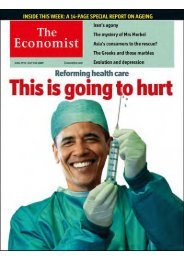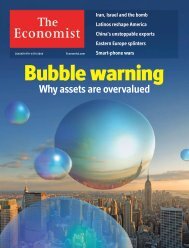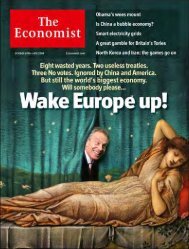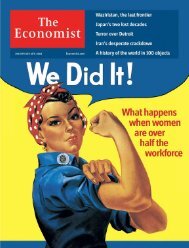Untitled - the ultimate blog
Untitled - the ultimate blog
Untitled - the ultimate blog
Create successful ePaper yourself
Turn your PDF publications into a flip-book with our unique Google optimized e-Paper software.
Democratic governor, has dangled more than $1 billion to attract alternative-energy firms, with about<br />
$700m in tax credits to develop electric-car batteries. Impressively, Michigan had <strong>the</strong> third-highest<br />
number of clean-tech patents from 1999 to 2008, behind only California and New York, reckons Pew. That<br />
number may rise. Last year Michigan passed a requirement for power companies to boost efficiency, along<br />
with an order that renewable sources account for 10% of <strong>the</strong> state’s electricity by 2015. Investments from<br />
<strong>the</strong> federal stimulus will help too. In <strong>the</strong> share-out on August 5th, Michigan won more grants for electric<br />
cars than any o<strong>the</strong>r state.<br />
Never<strong>the</strong>less, <strong>the</strong> clean-energy economy remains small. Though green jobs are increasing in number, <strong>the</strong>y<br />
accounted for only 0.6% of jobs in Ohio in 2007, according to Pew. The shares in Michigan and Indiana<br />
were even smaller, at 0.4% and 0.5% respectively. Manufacturing, for all its troubles, is a behemoth in<br />
comparison, accounting for 14% of employment in Ohio, 15% in Michigan and 18% in Indiana in 2007.<br />
And it is a dirty giant, dependent on cheap coal. The Midwest emits an outsize share of carbon, according<br />
to a report from <strong>the</strong> Chicago Council on Global Affairs. Indiana is one of <strong>the</strong> worst offenders, spewing out<br />
4% of America’s carbon emissions in 2007 though it is home to only 2% of its population.<br />
The fear is that a cap-and-trade bill may expand a promising new sector but devastate a struggling, larger<br />
one. Mitch Daniels, <strong>the</strong> Republican governor of Indiana, has worked hard to maintain his state’s<br />
manufacturing base. A price on carbon, he argues, would threaten it.<br />
The version of cap-and-trade passed in June by <strong>the</strong> House was meant to appease such critics. It includes<br />
help for manufacturers eager to retool for new industries. Allowances would be given away, not auctioned.<br />
And at <strong>the</strong> urging of a congressman from Michigan, <strong>the</strong> bill would, from 2020, tax imports from countries<br />
that do not restrict emissions. But some Democrats are still wary. Three of Indiana’s five House<br />
Democrats voted against <strong>the</strong> bill.<br />
Now a tough battle looms in <strong>the</strong> Senate. A new report from <strong>the</strong><br />
Energy Information Administration (EIA) forecasts that <strong>the</strong> House<br />
bill would depress industrial shipments by 1% between 2012 and<br />
2030 (see chart). But that assumes a quick expansion of nuclear<br />
plants, which is unlikely. In <strong>the</strong> EIA’s worst-case scenario,<br />
shipments would drop 3.2%. “They’re huxtering,” huffs George<br />
Voinovich, Ohio’s Republican senator, of <strong>the</strong> green enthusiasts. He<br />
wants more support for nuclear power and fears <strong>the</strong> House bill will<br />
transfer wealth from <strong>the</strong> heartland. On August 6th ten of Mr<br />
Voinovich’s Democratic colleagues, including six from <strong>the</strong> Midwest,<br />
wrote to Mr Obama fretting that a bill would cripple manufacturing<br />
industry.<br />
But in Toledo Xunlight’s president, Xunming Deng, looks forward to<br />
a cap-and-trade bill. “Of course <strong>the</strong>re is a cost, but this is an<br />
investment for our economy, for our future,” he says. There remains a danger, however, that compromise<br />
will produce a clunker of a bill—one that does little to slow climate change, little to revive <strong>the</strong> old economy<br />
and little to boost a new one. Much now depends on a handful of <strong>the</strong> states in <strong>the</strong> heartland.<br />
Copyright © 2009 The Economist Newspaper and The Economist Group. All rights reserved.<br />
-26-








![[ccebbook.cn]The Economist August 1st 2009 - the ultimate blog](https://img.yumpu.com/28183607/1/190x252/ccebbookcnthe-economist-august-1st-2009-the-ultimate-blog.jpg?quality=85)



![[ccebook.cn]The World in 2010](https://img.yumpu.com/12057568/1/190x249/ccebookcnthe-world-in-2010.jpg?quality=85)
![[ccemagz.com]The Economist October 24th 2009 - the ultimate blog](https://img.yumpu.com/5191885/1/190x252/ccemagzcomthe-economist-october-24th-2009-the-ultimate-blog.jpg?quality=85)